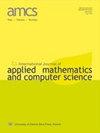A Data Association Model for Analysis of Crowd Structure
IF 1.2
4区 计算机科学
Q3 AUTOMATION & CONTROL SYSTEMS
International Journal of Applied Mathematics and Computer Science
Pub Date : 2022-03-01
DOI:10.34768/amcs-2022-0007
引用次数: 1
Abstract
Abstract The paper discusses a non-deterministic model for data association tasks in visual surveillance of crowds. Using detection and tracking of crowd components (i.e., individuals and groups) as baseline tools, we propose a simple algebraic framework for maintaining data association (continuity of labels assigned to crowd components) between subsequent video-frames in spite of possible disruptions and inaccuracies in tracking/detection algorithms. Formally, two alternative schemes (which, in practice, can be jointly used) are introduced, depending on whether individuals or groups can be prospectively better tracked in the current scenario. In the first scheme, only individuals are tracked, and the continuity of group labels is inferred without explicitly tracking the groups. In the second scheme, only group tracking is performed, and associations between individuals are inferred from group tracking. The associations are built upon non-deterministic estimates of memberships (individuals in groups) and estimates obtained directly from the baseline detection and tracking algorithms. The framework can incorporate any detectors and trackers (both classical or DL-based) as long as they can provide some geometric outlines (e.g., bounding boxes) of the crowd components. The formal analysis is supported by experiments in exemplary scenarios, where the framework provides meaningful performance improvements in various crowd analysis tasks.人群结构分析的数据关联模型
摘要本文讨论了人群视觉监控中数据关联任务的非确定性模型。使用人群组件(即个人和群体)的检测和跟踪作为基线工具,我们提出了一个简单的代数框架,用于维护后续视频帧之间的数据关联(分配给人群组件的标签的连续性),尽管跟踪/检测算法可能出现中断和不准确。在形式上,根据个人或群体在当前情况下是否可以更好地跟踪,引入了两种备选方案(实际上可以联合使用)。在第一种方案中,只跟踪个体,不显式跟踪群体,推断群体标签的连续性。在第二种方案中,只执行组跟踪,并从组跟踪推断个体之间的关联。这些关联建立在成员(群体中的个体)的非确定性估计和直接从基线检测和跟踪算法获得的估计之上。该框架可以包含任何检测器和跟踪器(经典的或基于dl的),只要它们可以提供人群组件的一些几何轮廓(例如,边界框)。形式分析得到了示例场景实验的支持,该框架在各种人群分析任务中提供了有意义的性能改进。
本文章由计算机程序翻译,如有差异,请以英文原文为准。
求助全文
约1分钟内获得全文
求助全文
来源期刊
CiteScore
4.10
自引率
21.10%
发文量
0
审稿时长
4.2 months
期刊介绍:
The International Journal of Applied Mathematics and Computer Science is a quarterly published in Poland since 1991 by the University of Zielona Góra in partnership with De Gruyter Poland (Sciendo) and Lubuskie Scientific Society, under the auspices of the Committee on Automatic Control and Robotics of the Polish Academy of Sciences.
The journal strives to meet the demand for the presentation of interdisciplinary research in various fields related to control theory, applied mathematics, scientific computing and computer science. In particular, it publishes high quality original research results in the following areas:
-modern control theory and practice-
artificial intelligence methods and their applications-
applied mathematics and mathematical optimisation techniques-
mathematical methods in engineering, computer science, and biology.

 求助内容:
求助内容: 应助结果提醒方式:
应助结果提醒方式:


